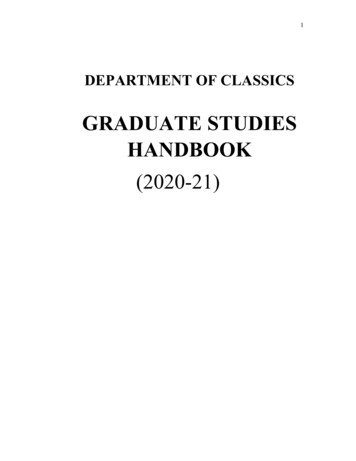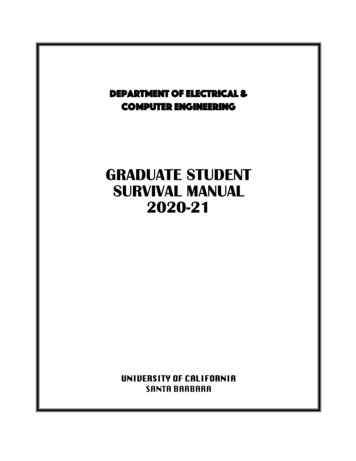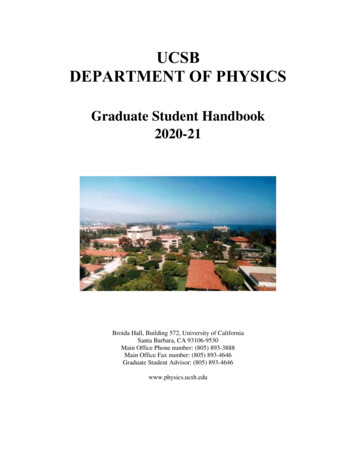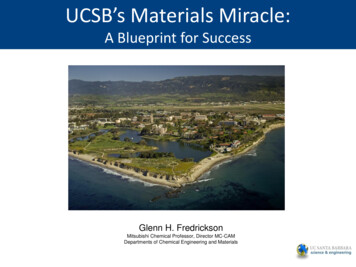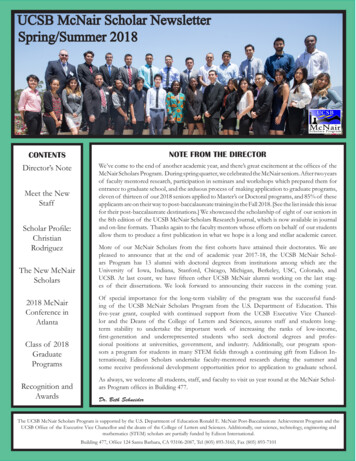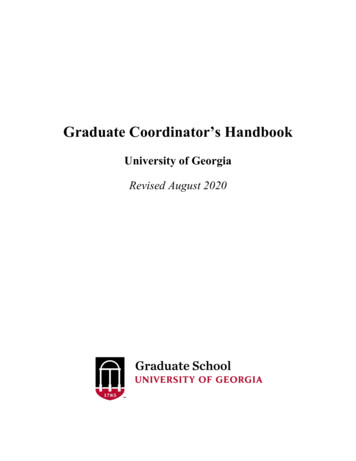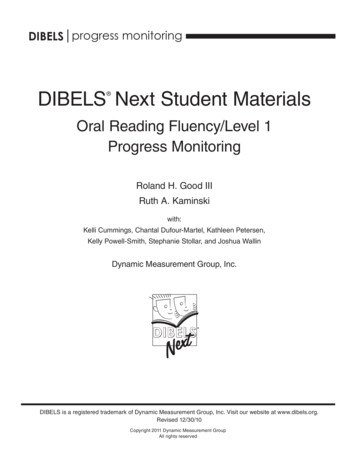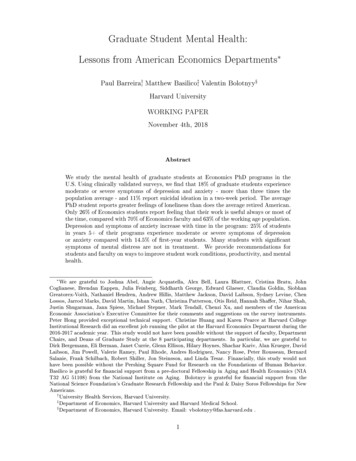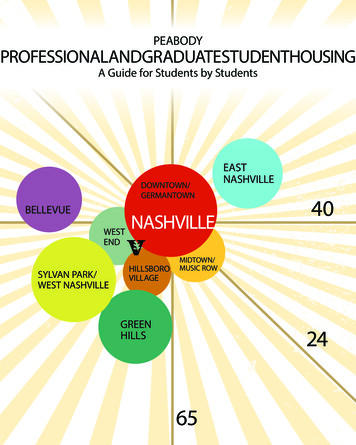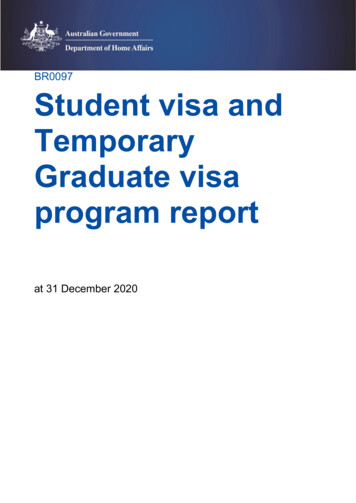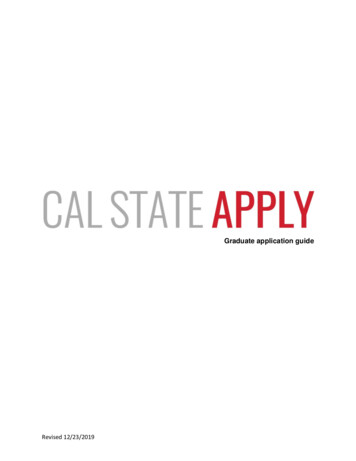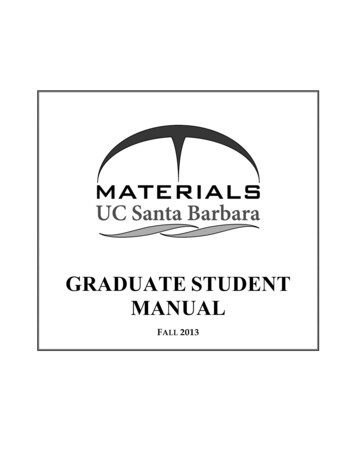
Transcription
GRADUATE STUDENTMANUALFALL 2013
TABLE OF CONTENTSWho’s Who in the Materials raduate Program GRAM.12Plan 1.12Plan 2.12Ph.D.PROGRAM.13Electronic/Photonic Materials Course Track.14Inorganic Materials Course Track.15Macromolecular/Biomolecular Materials Course Track.16Structural Materials Course ingStudentProgressThroughthePhDProgram.19Other Important CESS.24COMPUTINGFACILITIES.24ON- ‐LINERESOURCES.25CAMPUSMAP.262
Who’s Who in the MaterialsDepartment3
FACULTYProfessor* Tresa M. Pollock (Chair, ICMR Director)* Michael L. Chabinyc (Associate Chair)* Guillermo C. Bazan (CPOS Director)Matthew R. BegleyJohn Bowers (IEE/CEEM Director)Larry A. Coldren (OTC Director)* Steven P. DenBaars (SSLEC Co-director)* Craig Hawker (CNSI/DMI/MRL Director)Alan J. HeegerJacob N. Israelachvili* Edward J. Kramer* Carlos G. Levi (Dept. Graduate Advisor)Robert M. McMeeking* Shuji Nakamura (SSLEC Co-director)G. Robert OdetteChris PalmstrømPhilip A. Pincus (BMSE Director)* Cyrus R. Safinya* Omar Saleh* Ram Seshadri (MRL Co-Director)Hyongsok (Tom) Soh* James S. Speck (ICWBS Director)* Susanne StemmerGalen D. Stucky* Chris Van de Walle* Anton Van der VenClaude Weisbuch* Frank W. Zok (COEC Director)* Majority appointment in MaterialsJoint ularMacro/Biomolecular/ cStructuralPlease see Departmental Website (www.materials.ucsb.edu) for Emeriti and Affiliated Faculty.4
TECHNICAL STAFFKrystyna BrzezinskaBrian CarralejoMark CornishMike EdwardsJohn EnglishJerry HuMichael IzaBudd JamiesonStephan KraemerYouli LiTom MatesPeter MaxwellDeryck StaveAmanda StromDavid WhitlatchPolymer Lab ManagerMetalorganic Chemical Vapor Deposition LaboratoryMicroscopy (SEM)/ Specimen PreparationComputer ConsultantMolecular Beam Epitaxy (MBE) LaboratorySpectroscopy Lab ManagerMetalorganic Chemical Vapor Deposition LaboratoryComputer ConsultantFIB, TEM and MicroscopyX-ray Lab ManagerSIMS,XPS and Atom ProbeComposites and Nanoindentation Lab[1]sStructural Materials Processing Laboratory/CeramicsProcessing Lab/Sample PreparationTEMPO Lab ManagerMOCVDADMINISTRATIVE STAFFSheryl CondinoMary E. CummingsTravis DadigianHeather GardnerTawny HernandezAmanda KronickAubriana LaubeJoanne McNieDawn McTagueOura NeakTara OwensYukina WarnerAssistant to ProfessorsDenbaars, Nakamura, Speck, Van de Walle and WeisbuchAssociate ManagerContracts & Grants/ Payroll PersonnelReceptionist/Academic Personnel CoordinatorFinancial AnalystPurchasing CoordinatorAssistant to ProfessorsKramer, Levi, Pollock, Van der Ven and ZokAssistant to ProfessorsChabinyc, Pincus, Safinya, Saleh, Stemmer and SeshadriManagement Services OfficerStudent Affairs OfficerFinancial Manager, SSLECCorporate Programs Manager, SSLEC5
Introduction6
THE UC SYSTEMThe University of California was chartered as a land-grant college in 1868. Ten UC campusesare now situated throughout the state, in Berkeley, Davis, Irvine, Los Angeles, Merced,Riverside, San Diego, San Francisco, Santa Barbara, and Santa Cruz. Together, the campuseshave over 170,000 faculty members and a current enrollment of about 220,000 students. Aboutone-fourth of UC students are studying at the graduate and professional level. The Universityalso operates a variety of laboratories, agricultural field stations, extension offices, and otherfacilities. The University is the primary state-supported academic agency for research, and thepre-eminent system of public higher education in the country.The ten UC campuses are governed by the Regents of the University of California, a corporateboard of 26 members. The Regents in turn, delegate authority to the President, the Chancellor ofeach campus, and to the Academic Senate, which represents the faculty.THE UCSB CAMPUSThe UCSB campus was established in 1944 and moved to its present location on the site of aformer marine base in 1953. The 989 acre grounds include the main campus, the San Clemente,Santa Ynez and Storke apartments and the West campus. The student community of Isla Vista issurrounded by the UCSB campus and the Pacific Ocean.Within its beautiful setting, the University of California, Santa Barbara is a major researchinstitution offering undergraduate and graduate education in the arts, humanities, the socialsciences, and science and technology. Large enough to have excellent facilities for study,research, and other creative activities, the campus is also small enough to foster closerelationships among faculty and students. The total student population is about 22,000, withover 19,000 undergraduates and 3,000 graduate students. The UCSB faculty numbers over 1,000and includes five Nobel laureates, recipients of the National Medal of Science, members of theNational Academy of Sciences, the National Academy of Engineering, the American Academyof Arts and Sciences, Fellows of the Royal Society of London and the Royal Academy ofEngineering, numerous Guggenheim fellows, Fulbright scholars, and fellows of the NationalEndowments for the Arts and for the Humanities.The UCSB campus has 6 academic units: the College of Creative Studies, the College ofEngineering, the College of Letters and Sciences, the Gevirtz Graduate School of Education, theDonald Bren School of Environmental Science & Management and the Graduate Division.7
THE COLLEGE OF ENGINEERINGThe College of Engineering is the second largest undergraduate college at UCSB, includingapproximately 1350 undergraduate students and 750 graduate students. In recent years, theCollege has become one of the most dynamic engineering schools in the nation. It currently hasa full-time, permanent faculty of 145 and consists of five degree-granting departments: Chemical EngineeringComputer ScienceElectrical and Computer EngineeringMaterials (Graduate Only)Mechanical EngineeringThe College of Engineering is home to major funded Research Centers and Institutes, focused onMaterials, some international in scope, including: California NanoSystems Institute (CNSI)Center for Energy Efficient Materials (CEEM)Center for Multifunctional Materials and Structures (CMMS)Center for Polymers and Organic Solids (CPOS)Dow Materials Institute (DMI)Institute for Collaborative Biotechnologies (ICB)Institute for Energy Efficiency (IEE)Institute for Multiscale Materials Science (IMMS)Interdisciplinary Center for Wide Band-Gap SemiconductorsInternational Center for Materials Research (ICMR) – an NSF-funded IMIMaterials Research Laboratory (MRL) - an NSF-funded MRSECMitsubishi Chemical Center for Advanced Materials (MCCAM)Nanotech - UCSB Node of the National Nanofabrication Infrastructure Network (NNIN)Optoelectronics Technology Center (OTC)Solid State Lighting and Energy Center (SSLEC)SRC Nonclassical CMOS Research CenterUCSB Nanofabrication Research Center8
THE MATERIALS DEPARTMENTThe Materials Department at UCSB was established as a Graduate Program in 1985, and as anindependent department in early 1987, building on existing research programs in the College ofEngineering as well as the Physics and Chemistry Departments. The Department wasconceptualized and built under two basic guidelines: to educate graduate students in advanced materials andto introduce them to novel ways of doing research in a collaborative, multidisciplinaryenvironment.For the purposes of the academic program the Department is organized into four distinct butinterconnected areas specializing in electronic/photonic materials, macromolecular/biomolecularmaterials, structural materials and inorganic materials. Faculty, postdoctoral researchers, andstudents in the various specialties collaborate within and across these areas. Currently, theMaterials Department has approximately 160 graduate students and 28 faculty members, manyof who have joint appointments with other departments (page 4). In addition, approximately 40postdoctoral associates and visiting researchers are affiliated with the department in any givenyear.9
Graduate ProgramInformation10
PROGRAM OF STUDYThe Materials Department offers programs leading to the Ph.D. degree with specializations in thefollowing major areas: Electronic/Photonic Materials (compound semiconductors, electronicoxides, quantum structures and optoelectronic materials); Inorganic Materials (functionalmaterials for energy, magnetic or catalytic applications); Macro/Biomolecular Materials(synthesis, design and characterization of functional synthetic polymers -including selfassembling and conductive materials - and biopolymers, including biomembranes); andStructural Materials (materials for advanced energy and transportation systems, lightweight andthreat protection structures, mechanics of functional and biological systems).The curriculum in each area has the flexibility needed to provide multidisciplinary educationalopportunities in the field of advanced materials, encompassing topics such as optoelectronicdevices, semiconductor oxides, biomolecular systems and high temperature composites.Materials synthesis, processing and characterization feature prominently with courses in theprocessing of semiconductor materials, polymers and organic materials, alloys, ceramics,composites, as well as advanced topics in electron microscopy, spectroscopy and structuraltomography. Programs of study and research are individually tailored to accommodate researchneeds and student interest. Multidisciplinary education is strongly encouraged by means of jointfaculty supervision of research and by the selection of courses. Students are also encouraged tocross over traditional boundaries into other departments on campus (for example, Electrical andComputer Engineering, Mechanical Engineering, Chemical Engineering, Biological Sciences,Chemistry and Biochemistry, and Physics) through collaboration and taking courses in thosedepartments as appropriate. There is no foreign language requirement but all students areencouraged to explore opportunities for international research experiences at one of ourcollaborating institutions.The Materials Department does not require completion of an M.S. degree before advancing tothe Ph.D. Students interested in terminating their studies at the M.S. level should read thecorresponding section of this manual below.ADVISING AND ACADEMIC AFFAIRSDecisions regarding the M.S./Ph.D. program and graduate student affairs reside with theAcademic Affairs Committee. This committee consists of four faculty members, including theDepartmental Graduate Advisor and the Department Chair. The committee is responsible forapproving examination and dissertation committees upon consultation with the student andresearch advisors. The committee is also responsible for reviewing all petitions regardingexaminations and credit for courses taken elsewhere. It is also the focus for discussions andrecommendations concerning improvements in the graduate curriculum and examinationprocedures.Each student must select a research advisor within the first quarter of enrollment, preferablyearlier, based on mutual research interests and availability of research assistantships. Jointresearch advising by two faculty members is strongly encouraged to ensure that researchprograms have a strong multidisciplinary character.11
UCSB’S GRADUATE HANDBOOKBecause the Materials Graduate Program is designed primarily for doctoral students, thisdocument focuses on the specific degree requirements for the Ph.D. degree. A brief descriptionof the M.S. Program is given below for students interested in terminating at this level. (There isa separate manual for students in the BS/MS track, which is only available to UCSBundergraduates in the Electrical, Chemical and Mechanical Engineering BS programs, as well asto BS/BA students in Chemistry/Biochemistry.) Additional relevant information can be found inthe UCSB Graduate Policies and Procedures Handbook, available online atwww.graddiv.ucsb.edu/handbook/.MASTER’S PROGRAMCompletion of an M.S. degree on the way to the Ph.D. is neither required nor encouraged, unlessthere are special circumstances like a change in research topic. Students who elect this path mustfollow Plan 1 (below) achieve a 3.5 grade-point average in their coursework and pass thepreliminary examination as described on the “Ph.D. Program” section below. Students wishingto terminate their studies with a Master’s Degree may choose from the two Plans of Study below.All students in the BS/MS program must follow Plan 2 for the M.S. degree.Plan 1.Students in this plan are required to (1) complete 42 units including 27 units of formalcoursework, of which a minimum of 21 units must be approved 200 level courses (200-289), atmost 6 units of approved advanced undergraduate courses not used already for credit toward aprevious degree, 3 units of seminars (Matrl 290) and 12 units of thesis research (Matrl 598), and(2) submit an acceptable thesis based on original research. There is no oral defense of the M.S.thesis, but the thesis must be approved by a committee of three faculty members, including thestudent’s advisor. At least one committee member must have a majority appointment inMaterials, and one must have a non-zero appointment in Materials.Plan 2.Students in this plan are required to (1) complete 42 units of coursework including a minimum of27 units from approved 200 level courses (200-289), at most 6 units of approved advancedundergraduate courses not used already for credit toward a previous or concurrent1 degree, nofewer than 3 and no more than 6 units of independent studies or research (Matrl 596), and 3 unitsof seminars (Matrl 290), and (2) submit an acceptable engineering report based on theindependent studies. The report must be approved by a committee of two faculty members,including the student’s advisor. At least one member of the committee must have a majorityappointment in Materials.Appropriate course tracks for use in planning a program of study are presented in a subsequentsection. Further details are also available from the Materials Graduate Affairs Office.1Students in the BS/MS programs cannot use any courses toward both the BS and the MS degree.12
Ph.D. PROGRAMStudents are expected to complete the Ph.D. program within five years after entry at theBachelor’s level and within three years after entry at the Master’s level.Students admitted with a Bachelor’s degree are required to complete a minimum of 72 units ofacademic work structured in the following manner: 42 units of 200-level courses (excludingseminars and independent study), 15 units of seminars (Matrl 290) and/or independent studies,and 15 units of dissertation research (Matrl 599). Up to 8 units of upper division undergraduatecourses may be taken for credit toward the 200 level course requirements with prior approval ofthe student’s advisor. Students entering with a M.S. degree may petition to waive certain unitrequirements for the Ph.D. (up to 15 units of 200-level courses and a possible six units ofseminars) deemed to have been fulfilled by Master’s studies elsewhere. However, students arerequired to enroll in one unit of seminar (Matrl 290) for every quarter of residence they spend atUCSB, even if they have exceeded the unit requirement.All Ph.D. students are required to complete the following series of core courses in theappropriate sequence:Matrl 200A – Thermodynamic Foundation of MaterialsMatrl 200B – Electronic & Atomic Structure of Materials (Prerequisite: Matrl 200A)Matrl 200C – Structure Evolution (Prerequisite: Matrl 200A)In preparation for more advanced and specialized courses within their area of specialization,students are strongly encouraged to complete this core course sequence during their first year ofstudy. (These courses may not be waived). A minimum grade of B in each of these courses isrequire
The Materials Department at UCSB was established as a Graduate Program in 1985, and as an independent department in early 1987, building on existing research programs in the College of Engineering as well as the Physics and Chemistry Departments. The Department
